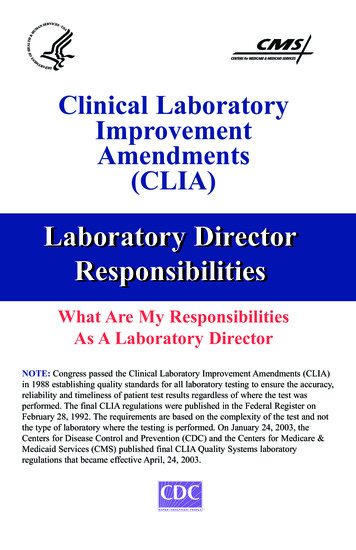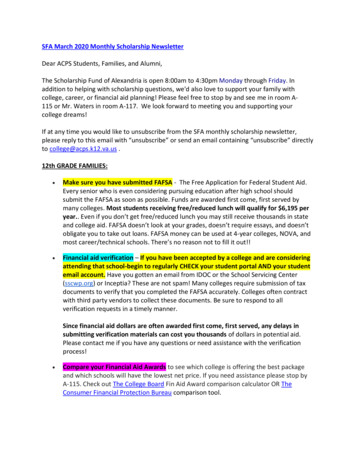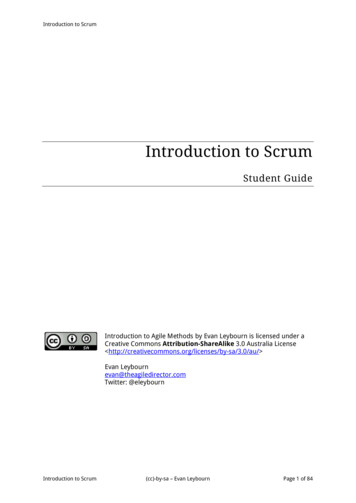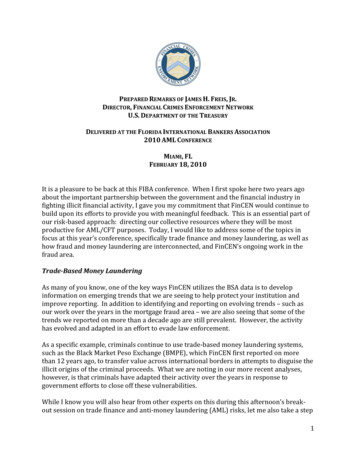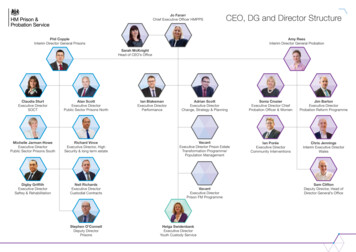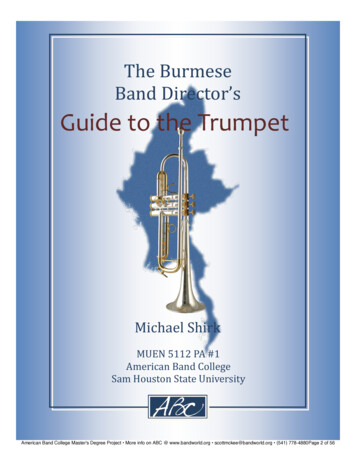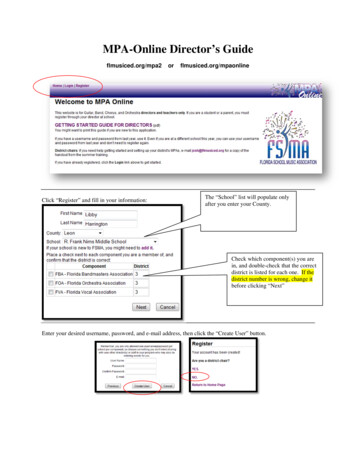
Transcription
DirectorT H E C O L L E G E S AV I N G S S O L U T I O NWest Virginia CollegePrepaid Tuition and SavingsProgram Board of TrusteesDirector SMART529 is issued by the West Virginia College Prepaid Tuition and SavingsProgram Board of Trustees and is administered by Hartford Life Insurance Company.
NOT INSURED BY FDIC OR ANY MAY LOSE NOT A DEPOSIT OF OR GUARANTEEDFEDERAL GOVERNMENT AGENCY VALUE BY ANY BANK OR ANY BANK AFFILIATEFDICBANK
Successin life can be measuredin degrees.To a child, the world is a place of boundless opportunity.The choice of what to be when he or she grows up is limitedonly by the imagination – for a while. At some point, the choiceof a profession – which most would agree has a major impact ona child’s future wealth and happiness – is restricted by whetherhe or she has a college education.The more you learn, the more you earn 73,892AverageAnnualIncome 48,724 36,348 30,316High SchoolGraduate(Including eMedian earnings in 2005 for year-round workers 25 years old and over.Source: U.S. Census Bureau, 2006.Earning a college degree can make a big difference in a child’sfuture income, as indicated in the chart above. Over a lifetime,the difference in income potential between having a high schooland a 4-year college education can be over 1 million. As youcan see, the gap is even greater when compared to having anadvanced degree. Whether you are a parent, grandparent, otherfamily member or friend, to help a child attend college is to givethem a long-term advantage in life.1
The cost of going isgrowingWhile paying for a collegeeducation may be the greatest giftyou can give, it may also be the mostexpensive. In 2005, the average cost forfour years of tuition, room and board at a privateinstitution was 116,104, and over the past 20 yearsboth public and private college expenses have risen ata rate more than twice that of inflation (as measuredby the Consumer Price Index).1How much one has to save for collegedepends heavily on whether the studentSince 1984, both public and private school tuition costshave increased almost 100%, while median familyincome has gone up only 17%.2 , This makes paying college costsfrom current income more difficult,particularly when sending more thanone child to school. Any money needed above what’savailable through saving or scholarships will have tobe borrowed, which increases the total amount spent.That’s why planning early and effectively for collegefunding is so important.will attend a public or private institution. How much is enough?Because that decision may not be madefor years into the future, it makes sense tosave enough so that the college attendedis a matter of choice, not chance.For help in determining how much youmay need to save, please contact your 293,741 300,000investment representative, or use ourSMART Family College calculator availableat www.hartfordinvestor.com. 250,000 203,645 200,000 180,331 125,020 100,000Cost of a4-year College Education 150,000 136,284Includes tuition, room and board, and assumes a 5% annualincrease. Based on 2005 enrollment-weighted data. 83,666PublicPublic (out of state) 50,000Private1 020102Years from now2 Source: Trends in College Pricing 2005, a survey of over2,800 U.S. post-secondary institutions conducted by TheCollege Board, a not-for-profit scholastic organization.Source: Trends in Student Aid 2005.On an inflation-adjusted basis.
Invest todayor borrowWhen you have a future goal for whicha large sum of money is needed, you ordinarilyhave two choices as to how to obtain it:investing or borrowing. When investing, yourtotal outlay is generally less than the amountneeded; if borrowing, the total is always more.?tomorrowThe chart below shows the total outlaynecessary if one were to invest an equal amounteach year over the number of years specified toreach a 200,000 goal, versus the total outlay ifone were to borrow 200,000 and pay it backin equal installments.Investing vs. Borrowing-20 InvestingYearsPrior -15toGoal -10-5 Goal05 BorrowingYearsAfterGoal101520 87,409 110,489 138,059 170,456 200,000 243,317 291,186 344,034 401,491Assumptions: The results are based on a 8% assumed annual rate, and do not reflect the actual performanceof any particular product or interest rate of any particular loan. The effect of taxes is not shown.3
Why it pays tostart todayTo maximize your college savings potential, it pays to make investmentsearly and often. By setting up a systematic investment plan from yourchecking or savings account, you can put even small amounts of moneyto work, and allow time and tax deferral to do their job*. Even thoughwhomever you’re saving for may not attend school for many years, thebest time to get started is right now.The following chart demonstrates the advantage of starting early. Itshows the amount you could potentially accumulate, depending on howmuch you invest each month and how many years you have left to save.As you can see, when it comes to investing for college, time can be yourgreatest asset.MonthlyInvestment15Years Left to Save101518Accumulated Amount 50 622 3,674 9,147 17,302 24,004 100 1,245 7,348 18,295 34,604 48,009 200 2,490 14,695 36,589 69,208 96,017 500 6,225 36,738 91,473 173,019 240,043Assumptions: a monthly investment earning a hypothetical 8% annual rate of return.This chart is not intended to reflect the performance of Director SMART529 investmentoptions, whose actual rates of return will fluctuate.* Continuous or periodic investment plans neither ensure a profit nor protect against a loss in declining markets. Becausethese programs involve continuous investing regardless of fluctuating price levels, you should carefully consider yourfinancial ability to continue investing through periods of fluctuating market prices.4
Make saving a little lesstaxingBecause Director SMART529 assets are not taxed annually, more moneycan potentially accumulate for college over time. This is because moneythat ordinarily would be paid out in current taxes remains invested,allowing any earnings to compound.If taken for a qualified higher education expense, withdrawals arefederal income tax free, so 100% of the money can be used forwhat it was intended: education.1 The chart below depicts theconsiderable difference this makes over time relative to ordinarytaxable investments.Time and TaxesTax FreeTaxableAssumptions: the results are based ona 25,000 lump-sum investmentwith 250 added per month, 225,000 growing at a hypothetical 8%rate of return; the taxable resultsassume an annual federal tax 185,000 rate of 28%. 219,922 163,133 145,000 105,000 65,000 25,000123456789 10 11 12 13 14 15 16 17 18YearsThis chart is not intended to reflect the performance of Director SMART529 investment options, whose actual rates of return will fluctuate.1State income tax treatment may differ.Non-qualified withdrawals are taxable as ordinary income to the extent of earnings and may also be subject to a 10% federal income tax penalty.Such withdrawals may have state income tax implications.5
5 2 9 Simply put, a 529 savings plan can make your efforts to save for college easierand more effective. That’s why the State of West Virginia and The Hartford areproud to bring you Director SMART529, a plan that provides all of the advantagesthis type of plan has to offer:Eligibility Any U.S. citizen or resident can open an account, as can corporations and non-profit organizations Parents, grandparents, other family members and friends can all open or add to an accountfor a beneficiary No additional restrictions based on age, income or state of residencyFlexibility Low investment minimums and a high maximum limit Money can be added at any time The beneficiary on the account can be changed, without incurring a federalincome tax liability, as long as the new beneficiary is an eligible family memberof the current beneficiary (includes a spouse, sibling, grandchild or even first cousin)Choice The account owner maintains complete control of withdrawals The account owner chooses from a range of professionally managedinvestment options There are no set deadlines for use of plan proceeds12346Any additional gifts to the same Designated Beneficiary in that 5-year period would be subject to federal gift tax.If the donor elects to treat a gift as being made over 5 years, and the donor dies prior to the end of that 5-year period, the portion of the gift allocable to the periodafter the donor’s death will be included in the donor’s estate. Estate tax treatment may differ by state. Please consult your tax advisor for more information.West Virginia offers special state tax incentives for West Virginia taxpayers who invest in Director SMART529. If you are a resident of a state other than West Virginia,before investing in Director SMART529, you should compare your own state’s qualified tuition program and any state tax or other advantages it may provide.IRS Form 1099-Q will be sent for any year in which a withdrawal is made.
SMARTTax Benefits Withdrawals taken for qualified higher education expenses are completely federal income tax free(Non-qualified withdrawals are taxable as ordinary income to the extent of earnings and may also besubject to a 10% federal income tax penalty. Such withdrawals may have state income tax implications) Up to 60,000 per donor can be gifted to a beneficiary once per 5-year period without incurringfederal gift tax by filing IRS Form 7091,2 Amounts invested are removed from the donor’s taxable estate,2 and can qualify as anincome-reducing deduction for West Virginia personal income tax purposes3 There is no current taxation of account growth, or annual IRS Form 10994 If the student earns a scholarship, that amount may be withdrawn without afederal income tax penalty7
Choosefor yourself how best to investBecause investors differ in how long they plan to invest, and in how much risk they are willing and able to take,Director SMART529 offers a range of investment options designed to meet a variety of needs.With Director SMART529, money can be transferred tax free between any of the investment options once per calendar year,and the allocation for new contributions can be changed at any time. For more information about the investment options,please refer to the Offering Statement.Age-Based Portfolios*For your convenience, Director SMART529 also offers four Age-Based Portfolios, each of which has an asset allocationdesigned for children in a particular age group. Your account value is automatically transferred between the portfoliosbased on the child’s age, so there is greater growth potential when the child is young, and a more conservativeallocation when the money is soon to be needed. Following are the portfolios and their allocations:Age-Based Portfolio14 - 18 years old Age-Based Portfolio9 - 13 years old Age-Based Portfolio0 - 8 years oldAge-Based Portfolio19 years old20%30%50%100%50%70%80%Static Portfolios*There are three Static Portfolios, each comprised of a different combination of Underlying Funds. The main differencebetween the portfolios is their allocation between equity-oriented (stock) funds and those that invest in fixed income(bond and stable value) instruments.Growth Portfolio For those investing for youngchildren, or who are willing totake more risk to have thepotential for higher returns. Aggressive Growth PortfolioBalanced PortfolioFor investors who want a highdegree of growth potential,but with less risk than anall-equity portfolio.For investors with a shorter timehorizon, or who are willing to takeonly moderate investment risk.20%40%100%60%80%RebalancingTo make sure that the intended investment allocation is maintained, both the Static and theAge-Based Portfolios automatically rebalance on a quarterly basis.EquitiesFixed Income8* For details regarding the actual composition of the Investment Portfolios, please see the Offering Statement.
Individual Fund OptionsYou can invest directly in any of the Individual Fund Options indicated, and create your own customizedasset allocation. The following can be purchased individually, or in any combination:The Hartford Capital Appreciation 529 Fund 1The Fund seeks growth of capital by investing in companies of all sizes based solely onthe potential for capital appreciation.Equity HigherRisk/HigherPotentialReturnThe Hartford MidCap 529 Fund 1,2The Fund seeks growth of capital by investing primarily in stocks of mid-cap companies selected onthe basis of potential for capital appreciation.The Hartford Global Leaders 529 Fund 1The Fund seeks long-term growth of capital by investing primarily in stocks issued by companies worldwide.The Hartford Stock 529 Fund 1The Fund seeks long-term growth of capital, with income as a secondary consideration, by investingprimarily in stocks of high quality growth companies.The Hartford Dividend and Growth 529 Fund 1The Fund seeks a high level of current income consistent with growth of capital by investing primarily in stocks. BalancedThe Hartford Advisers 529 Fund 1The Fund seeks maximum long-term total return by allocating its assets among stocks, bonds and moneymarket instruments.The Hartford High Yield 529 Fund1,3The Fund seeks high current income. Growth of capital is a secondary objective. The Fund normally invests at least80%, and may invest up to 100%, of its assets in non-investment grade debt securities.FixedIncome LowerRisk/LowerPotentialReturn1The Hartford Total Return Bond 529 Fund 1,3The Fund seeks a high level of current income, consistent with a competitive total return, as compared to bond fundswith similar investment objectives and policies, by investing primarily in debt securities.2The Hartford Inflation Plus 529 Fund1,4The Fund seeks a total return that exceeds the rate of inflation over an economic cycle. The Fund pursues its objectiveby investing, under normal circumstances, at least 65% of its net assets in inflation-protected debt securities of all types.3The SMART529 Stable Value FundThis conservative investment portfolio seeks to maximize current income while preserving principal and deliveringstable investment returns.4A percentage of the underlying fundmay invest in foreign issuers andnon-dollar securities which mayinvolve different and additional risksassociated with foreign currencies,investment disclosure, accounting,securities regulation, commissions,taxes, political or social instability,war or expropriation. These risks areheightened in developing markets.The Fund invests all or a portion ofits assets in small to midsize companies. Such investments increasethe risk of greater price fluctuations.The fund invests in securitiesrated “BB” and below, which arecommonly referred to as “high yield,high risk securities” or “junkbonds.” High yield bonds generallyinvolve greater credit risk and maybe more volatile than investmentgrade bonds.The Fund is subject to interest raterisk, which is the risk that wheninterest rates rise, bond prices mayfall. Additionally, the Fund is subjectto income risk, which is the potential for a decline in the Fund'sincome due to falling interest rates.9
Earn from their experienceThe investment options available through Director SMART529 are managed by Wellington Management Company, LLP,Hartford Investment Management Company, and INVESCO Institutional, Inc.Experienced Traces its origins to 1928 Over 528 billion in assets under management(as of 6/30/06) Wellington Management portfolio managers average 18years of investment experience, with 10 years at the firm Wellington Management’s 45 Global Industry Analystsaverage 17 years of investment experienceFocused Managing money is Wellington Management’sonly business This focus enables Wellington Management to directits extensive resources towards the fulfillment of a singlegoal: The pursuit of superior investment returns for theirclientsEstablished One of the largest independent U.S. investment firmsfocused exclusively on money management 414 investment professionals, including 95 portfoliomanagers and 156 research analystsResearch Driven Proprietary fundamental research drives investmentdecisions 18 of the firm’s 95 partners are Global Industry AnalystsStrength in Numbers Entrusted with over 118 billion in assets undermanagement*Breadth of Resources More than 97 dedicated investment professionalsproviding extensive coverage of global bonds Portfolio managers average more than 18 years ofinvestment experience and 9 years with the firm Credit analysts and traders average more than 13 yearsof professional experienceIndependent Research Research is conducted in-house Extensive credit and quantitative research resources allowHartford Investment Management to capitalize on awide variety of opportunities across the credit spectrumLong-Term Perspective Approach reflects an understanding of interest cycles andhistorical trends – not just today’s current environment Performance target of consistent value-added returnsversus peers and benchmarks* as of 6/30/06. Includes wholly owned subsidiary. Part of the 414 billion AMVESCAP PLC global investment management organization Began stable value management in 1985, now with over 47 billion under management (as of 6/30/06) An industry leader in managing stable value funds for retirement, 529 and other plans, committed toproviding the highest quality portfolio managementDirector SMART529 is issued by the West Virginia College Prepaid Tuition and SavingsProgram Board of Trustees and is administered by Hartford Life Insurance Company. Hartford Life is part of The Hartford Financial Services Group, which has helped to protectindividuals, businesses and families since 1810. The Hartford’s life operation is the nation’s fourth largest life insurance group based on assets.** Based on 2005 year-end admitted asset data from A.M. Best.10
Any Questions?What expenses can I save for?Account proceeds can be used to pay qualified higher education expenses of theDesignated Beneficiary. These include tuition, fees, room, board, and books,supplies and equipment required for attendance at an eligible institution.Expenses such as transportation costs and miscellaneous personal expenses arenot considered qualified expenses under Section 529.Where can I use account proceeds?Account proceeds can be used at eligible institutions nationwide. An EligibleEducational Institution is any college, university, vocational school, or otherpostsecondary educational institution eligible to participate in a student aidprogram administered by the U.S. Department of Education. It includesvirtually all accredited colleges, universities and other postsecondary institutions.To check institution eligibility, call the Federal Student Aid Information Centerat 800-433-3243.What happens if the Designated Beneficiary does not attendan Eligible Educational Institution?In that scenario, the Account Owner has three options: (1) leave the money inthe Account, in the event that the Designated Beneficiary decides to attendschool at a later date, (2) change the Designated Beneficiary on the Accountto another Eligible Family Member, or (3) withdraw the Account value, whichwould be subject to ordinary income tax to the extent of earnings, a 10% federalincome tax penalty, 50 Account Cancellation Charge and if previously taken,the recapture of any West Virginia personal income tax deduction.What happens if the child receives a scholarship?If the Designated Beneficiary receives a grant or scholarship for qualified highereducation expenses, that amount can be withdrawn from the account without a10% federal tax penalty. The earnings portion of the distribution will be subjectto ordinary income tax if not used for qualified higher education expenses.Proper documentation of the scholarship may be required.Can I make automatic monthly contributions to my account?Yes, the Automatic Investment Plan allows monthly contributions from yourchecking or savings accou
Simply put, a 529 savings plan can make your efforts to save for college easier and more effective. That’s why the State of West Virginia and The Hartford are proud to bring you Director SMART529, a plan that provides all of t
